This is the website of Abulsme Noibatno Itramne (also known as Sam Minter).
Posts here are rare these days. For current stuff, follow me on Mastodon
|
Trump won New York 90 to 5. Those 5 delegates went to Kasich.
If there was any surprise here, it was that Trump got a few more delegates than expected. I didn’t track it in detail, but my impression was that most people expected a result in the 80’s.
In addition, since Wyoming there was an update to the delegate count in Georgia that moved one delegate from Trump to Cruz. So the net change since Wyoming was Trump +89, Kasich+5, Cruz +1.
So Trump got 93.68% of the delegates since Wyoming. He only needed 58.17% of the delegates. He easily cruised past this bar. So where does this put things?

In raw delegates we now have Trump 849, Cruz 559, Rubio 173, Kasich 150, Carson 9, Bush 4, Fiorina 1, Huckabee 1, Paul 1. We have 725 delegates still outstanding or uncommitted. 1237 delegates are needed to win.
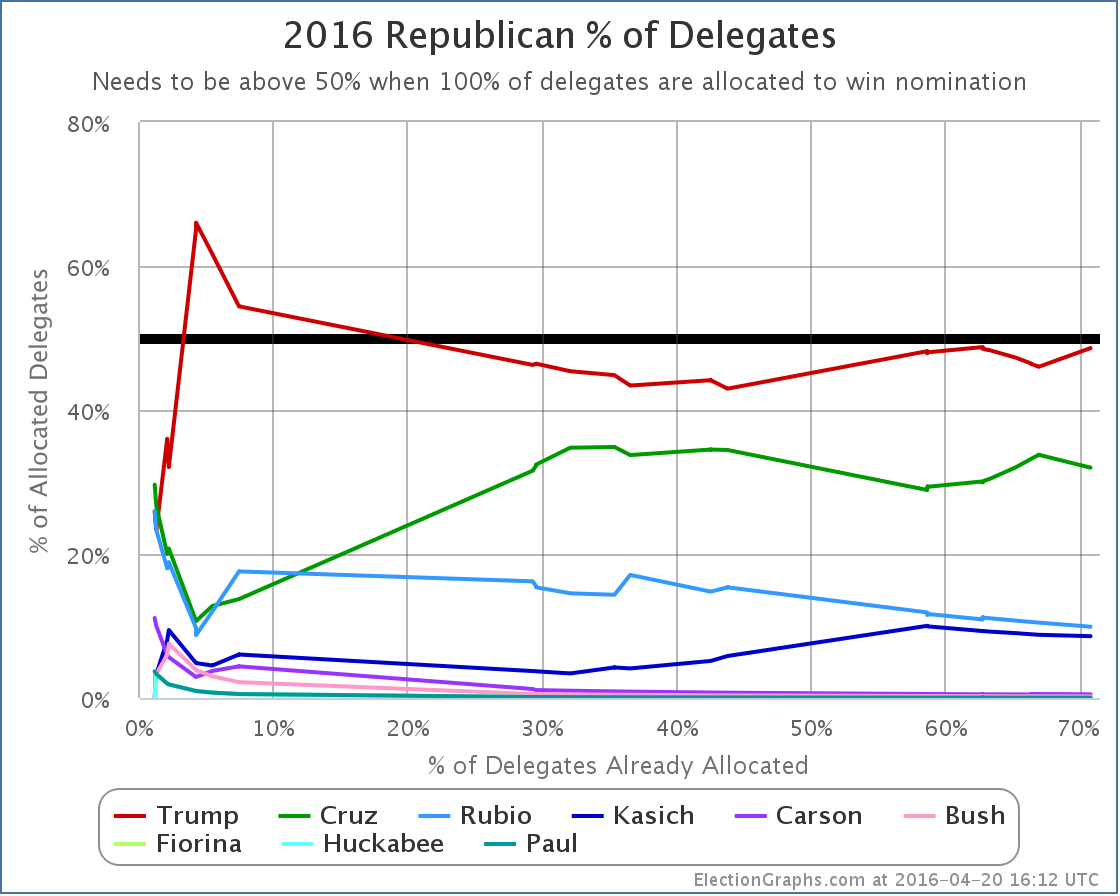
In percentage terms Trump now has 48.60% of the delegates determined so far. He is very very close to the magical 50% mark, but not quite there.
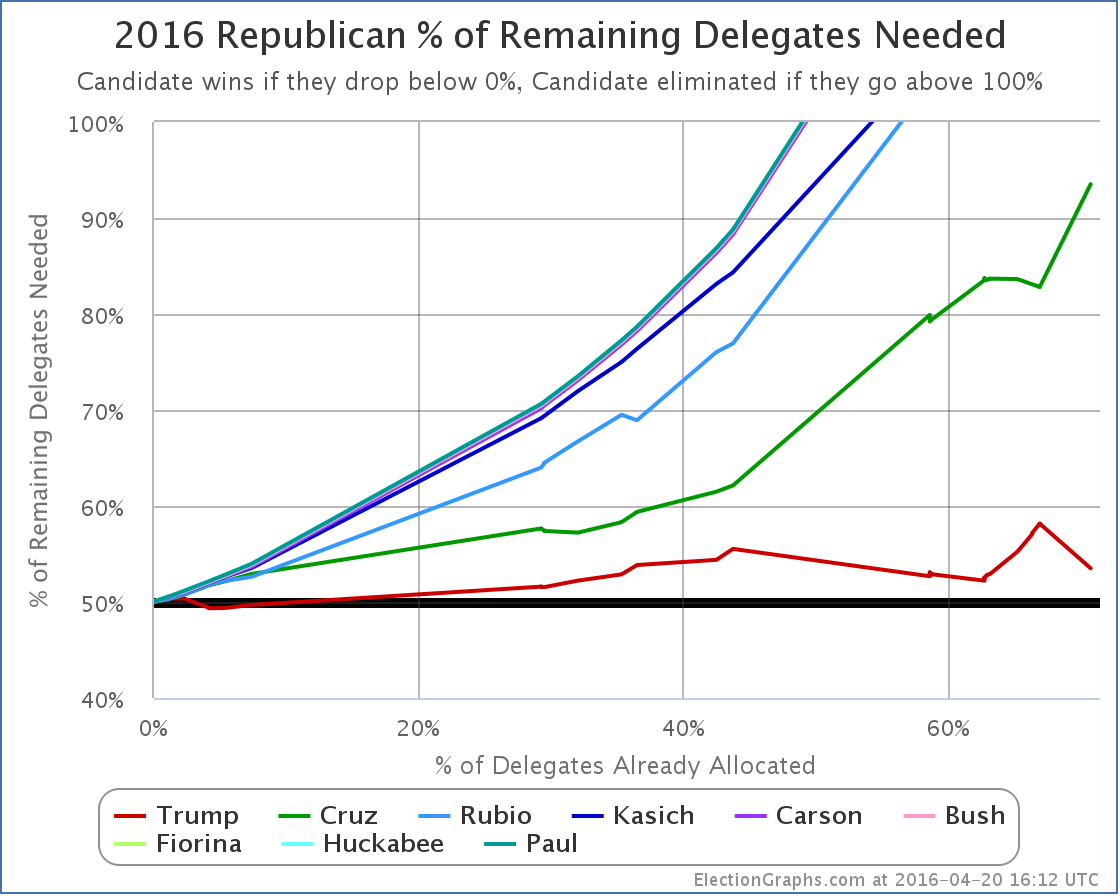
So time to look at the all important “% of remaining delegates needed” graph. As mentioned in the post here about Wyoming: If Trump did as well as was expected, he would undo most, but not all, of the damage done by Cruz’s recent series of wins, and that is exactly what played out.
Trump was down to 52.22% before his series of losses. After those losses he was up to 58.17%. Now he is back down to 53.52%.
Trump needs to get at least 53.52% of the remaining delegates… including officially uncommitted delegates… to get to 1237 and win this thing outright. Even one delegate short of that, and we’re in the multi-ballot convention zone.
The next few states are all very favorable for Trump. Next Tuesday we have Pennsylvania, Maryland, Connecticut, Rhode Island, and Delaware. Trump is expected to win all of them, by significant delegate margins. It is very possible that he will be over 50% of the delegates allocated so far at that point.
But then he has to keep it. Trump will still be right on the edge. He does a little worse, we have a multi-ballot convention, he does a little better, he wins on the first ballot.
So what are Trump’s odds of getting to 1237? This is unclear. But what is clear is that we are not yet at the point where we can say that either the path to an outright Trump win, or the path to a multi-ballot convention is undeniably the likeliest outcome.
Trump can still get an outright majority of delegates. This is very plausible. It is a reasonable possibility, not just a fantasy.
Some people (including me) have characterized this as a narrow path that Trump has to get nearly perfectly. That would seem to imply relatively low odds of this outcome. Maybe 10% or 20%. (Although I gave 40% as my odds in my podcast.)
On the other extreme, you have Sam Wang putting Trump’s odds of getting to 1237 at 64%. (That was before New York, but New York played out as good or better than Wang expected, so if anything that is now low.)
Looking at the simulators at The Upshot and FiveThirtyEight you see that it is still very easy to get Trump to the magic number. You usually have to use uncommitted delegates though. Trump will need to convince some more of them to come his way.
So maybe Trump is at 30% to win outright, or maybe he is at 64%. Either way, these are odds where either outcome would not be surprising. We’re basically still in the tossup zone. We are STILL right on the edge between Trump and a multi-ballot convention. And we might stay right on that edge straight through the end of the primaries and caucuses in June… or even all the way to the convention if the uncommitted delegates don’t start letting us know what their true preferences are.
Unlike the Democratic side, where Clinton has just been slowly but surely grinding out a win, here on the Republican side we have real drama. None of the others running can realistically win outright, but they CAN still stop Trump from winning outright and force a contested convention.
And so it continues…
[Update 2016-04-27 17:28 UTC: Updated uncommitted numbers from North Dakota. Net Cruz +2.]
Note: This post is an update based on the data on ElectionGraphs.com. Election Graphs tracks both a poll based estimate of the Electoral College and a numbers based look at the Delegate Races. All of the charts and graphs seen in this post are from that site. Additional graphs, charts and raw data can be found there. All charts above are clickable to go to the current version of the detail page the chart is from, which may contain more up to date information than the snapshots on this page, which were current as of the time of this post. Follow @ElectionGraphs on Twitter or like Election Graphs on Facebook to see announcements of updates or to join the conversation. For those interested in individual general election poll updates, follow @ElecCollPolls on Twitter for all the polls as they are added.
Clinton won New York 139 to 108.
This is only a surprise to Sanders supporters who were in deep denial. This is exactly as has been expected for many many weeks. The series of Sanders wins prior to this were also mostly predicted. The one exception (Michigan, where Sanders did outperform expectations) wasn’t enough of a win to actually help Sanders. The Clinton vs Sanders wins and losses have for the most part played out very close to expectations. The variations from that have only been a few delegates here or there.
The breathless talk of momentum and talk of a Sanders path to victory has mostly been due to the Sanders camp desperately trying to spin whatever narrative they have, the general public not understanding how the process works (yes, superdelegates count), the public not understanding the math (even massive Sanders wins at this point aren’t enough to catch up and win), and the media hopelessly biased toward a race being more fun to cover than just monitoring progress toward an almost inevitable result.
It has been clear since around March 6th… at the LATEST… probably earlier to be honest… that absent a major Clinton implosion, Clinton would be the nominee and Sanders wasn’t going to catch her.
And yes, yes, even today… for that matter even up until the actual votes are cast at the convention… there is still that chance of a Clinton implosion. There could be some new scandal, some new health event, or something else, that causes even Clinton supporters to abandon her. That would potentially change everything, even if Clinton already has things wrapped up mathematically.
Absent that though, this result has been clear for a long time, and we are just watching the steps to get there.
In addition to New York, since the last democratic contest in Wyoming there have been a variety of superdelegate changes, plus revised results from Colorado. The net result of all of those was Sanders +5, Clinton -2. Those are good numbers for Sanders, but small.
Add in New York and the results since Wyoming are Clinton +137, Sanders +113.
That means Clinton got 54.80% of the delegates. She only needed 32.23%.
Sanders got 45.20% of the delegates. He needed 67.84%.
So the already nearly impossible Sanders path gets even more remote.
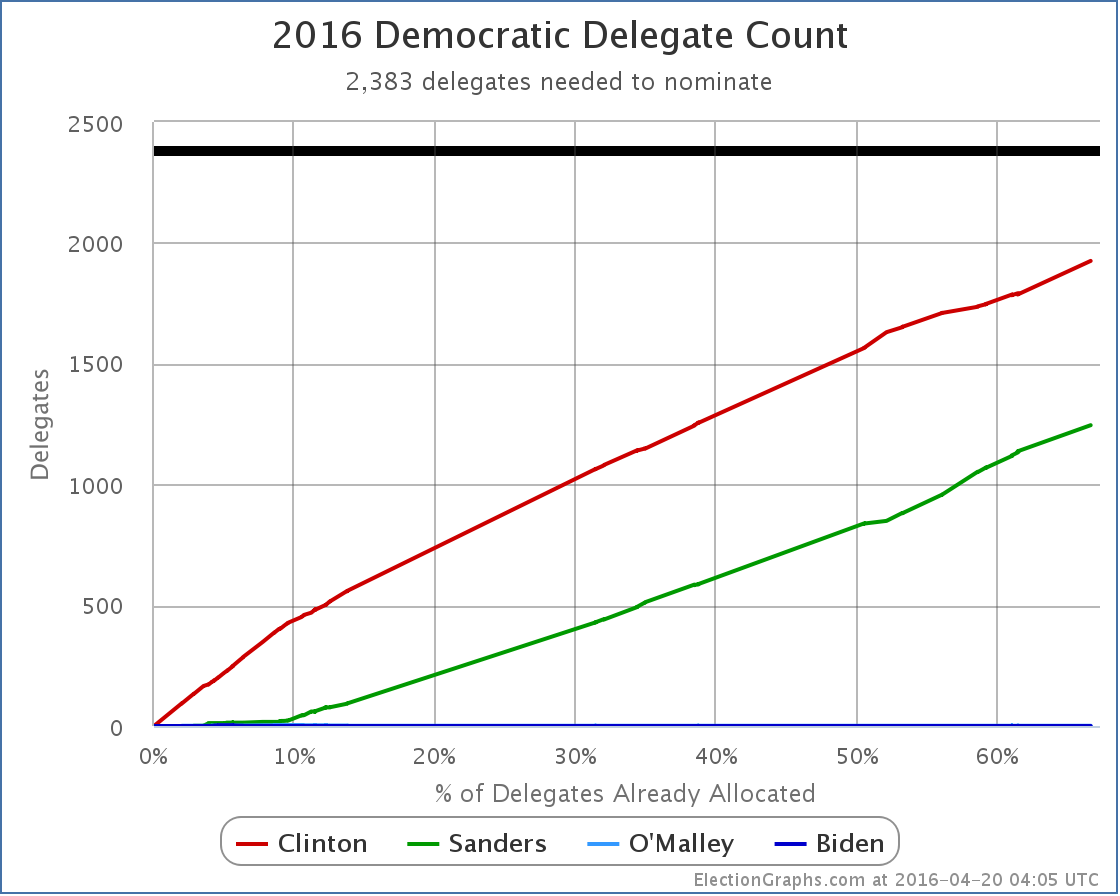
I don’t usually post the raw delegate count graph, but we are now in sight of the finish line.
We now have Clinton 1925, Sanders 1245, O’Malley 1. With 1594 delegates still to be determined, and 2383 needed to win the nomination.
You can see that since primaries and caucuses began (around the 9% mark), with only a few exceptions here and there, the pace at which both candidates have collected delegates has been pretty steady. (If you look at this with a date axis it looks much more jagged, but this is all just distortion caused by the way the states happened to be scheduled, looking at % allocated removes this distortion and allows you to look more cleanly at the actual trends.)
Clinton has been consistently ahead, and except for a few short exceptions has been gradually increasing her lead.
It is clear even from this chart that to catch up before we get to 100% there would need to be a dramatic change, not just a small improvement on the Sanders side.
But lets look at the more telling “% of remaining delegates needed” graph:
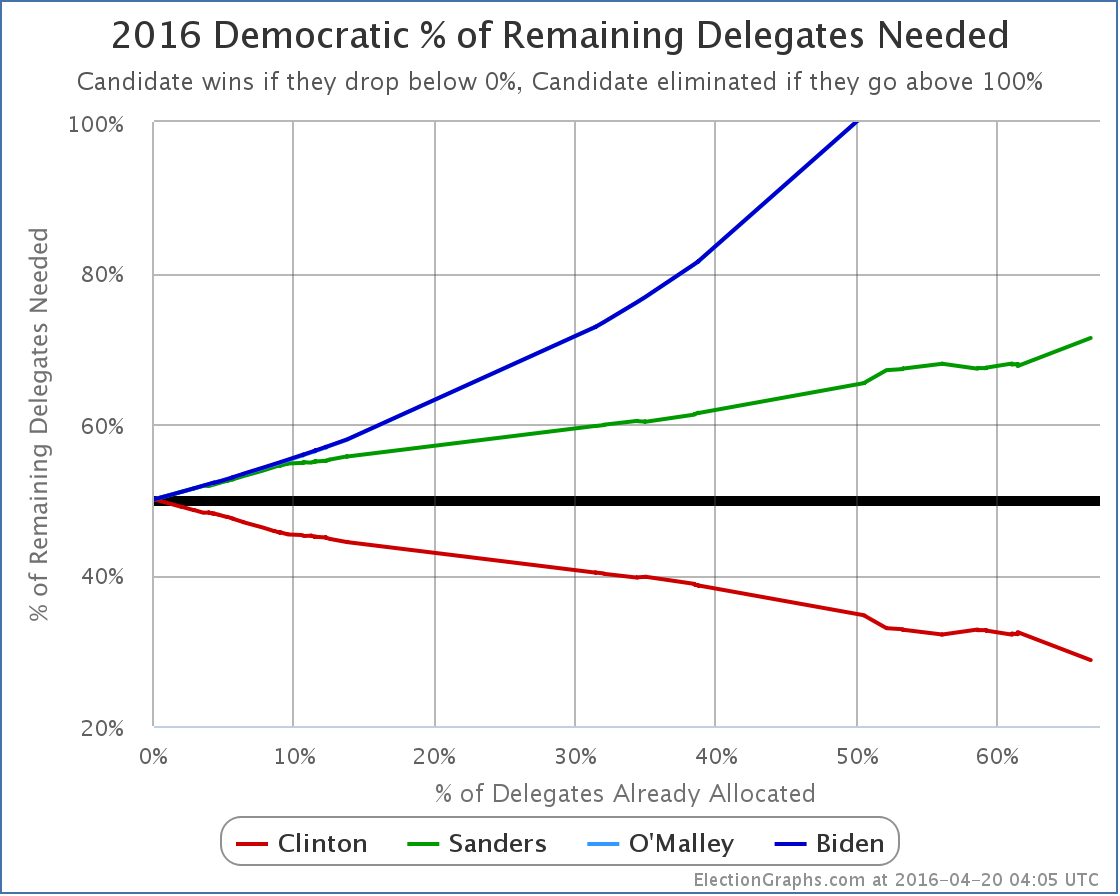
Sanders now needs 71.39% of the remaining delegates (including the remaining superdelegates) to catch up and win the nomination.
Meanwhile, Clinton only needs 28.73% of the remaining delegates.
Or, as always, this changes if a massive wave of Clinton superdelegates start changing their minds and going over to Sanders. That hasn’t happened so far, and absent the Clinton implosion discussed earlier, is very unlikely to happen now.
We will probably still keep hearing about it not being over until the vote at the convention because the superdelegates might change their minds though. Because they CAN change their minds. But they tend not to. It is over. It has been for a long time.
Absent the Clinton implosion of course.
[Edit 16:42 UTC to add the raw delegate totals.]
[Update 2016-04-24 00:13 UTC – Superdelegate scan: Clinton +2]
[Update 2016-04-26 16:18 UTC – Superdelegate scan and updates in Illinois and Ohio. Net change: Clinton +3, Sanders +1.]
[Update 2016-04-27 16:55 UTC – Superdelegate scan: Clinton +4]
Note: This post is an update based on the data on ElectionGraphs.com. Election Graphs tracks both a poll based estimate of the Electoral College and a numbers based look at the Delegate Races. All of the charts and graphs seen in this post are from that site. Additional graphs, charts and raw data can be found there. All charts above are clickable to go to the current version of the detail page the chart is from, which may contain more up to date information than the snapshots on this page, which were current as of the time of this post. Follow @ElectionGraphs on Twitter or like Election Graphs on Facebook to see announcements of updates or to join the conversation. For those interested in individual general election poll updates, follow @ElecCollPolls on Twitter for all the polls as they are added.
This week on Curmudgeon’s Corner Sam and Ivan talk about Election 2016 of course. But first some bits about Mike the headless chicken, the comments on Sam’s Election Graphs site, stamp prices, Hey Siri, and a movie Sam watched. When they do get to the election they cover Trump’s shutout in Colorado, Trump’s general malpractice in delegate wrangling, the odds of a contested convention, the accusations of cheating in both parties, and much more!
Click below to listen or subscribe… then let us know your own thoughts!

Recorded 2016-04-14
Length this week – 1:20:15
 1-Click Subscribe in iTunes 1-Click Subscribe in iTunes
 View Podcast in iTunes View Podcast in iTunes
 View Raw Podcast Feed View Raw Podcast Feed
 Download MP3 File Download MP3 File
 Follow the podcast on Facebook Follow the podcast on Facebook
Show Details:
- (0:00:41-0:22:29) But First
- Ivan in his Car
- Mike the Headless Chicken
- Election Graphs Comments
- Stamp Prices
- Facebook Bots
- Hey Siri
- Movie: Mississippi Burning (1988)
- (0:23:08-1:00:14) Election 2016
- Trump shutout in Colorado
- Delegate wrangling malpractice
- Contested Convention Scenarios
- Ryan saying no… Again
- Odds of Trump getting majority
- Trump Trends
- Cruz wooing delegates
- (1:00:53-1:19:55) Election 2016 Continued
- Cheating? Stealing? Unfair? Rigged?
- Sanders “contesting” the convention
- Sanders attempts to woo superdelegates
- Edit wars on Wikipedia Superdelegate list
- Denial from Trump and Sanders people
- What Sanders and Trump didn’t do
- When is New York again?
- Thoughtful Trump people wanted
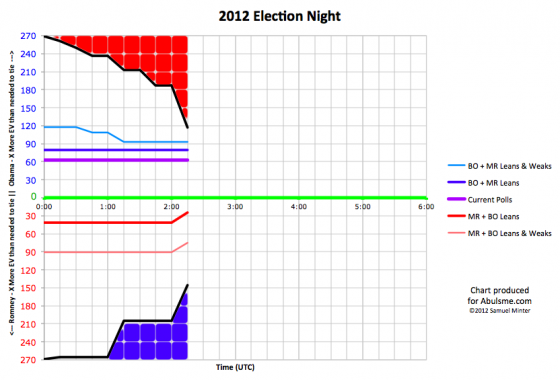
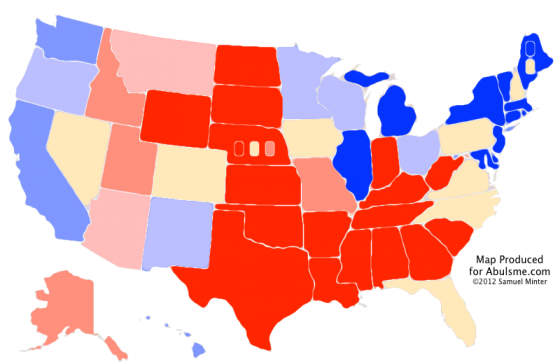
|
Romney |
Obama |
| Romney Best Case |
294 |
244 |
| Current Status |
206 |
332 |
| Obama Best Case |
190 |
348 |
No states were called between 01:45 UTC and 02:00 UTC, but a ton were called between 02:00 UTC and 02:15 UTC:
- Romney: KS, LA, NE-All, NE-1, ND, SD, TX, WY, MS
- Obama: MI, NY, NJ
All of these were no brainer expected states, except for Michigan. Michigan is the first state of the night to be called where the margin was less than 5% in the polls, so winning this state made a difference between the “best cases” that I present. Obama was ahead here by 4.5%, so a win here was predicted, but it was a close state and one that Romney really needed.
As of the final update I made on election day, Michigan was the tipping point state. That means Romney had to win all the states he was doing better in than Michigan PLUS Michigan in order to win. He just lost Michigan, which means he now needs a state he was further behind in that Michigan in order to win.
This is very bad news to Romney. His path to victory is now not quite impossible, but very close. Let’s look:
With all the states he has already won, plus the uncalled states where Romney was ahead by more than 5%, he had 190 electoral votes. Then the areas he was ahead in:
- Nebraska 2nd (1): 3.8% Romney lead
- North Carolina (15): 1.4% Romney lead
That gets Romney to 206. He needs 63 more electoral votes. Looking at the remaining states that haven’t yet been called:
- Iowa (6): 2.0% Obama lead
- Florida (29): 2.3% Obama lead
- Colorado (9): 2.4% Obama lead
- New Hampshire (4): 2.8% Obama lead
- Maine 2nd (1): 2.8% Obama lead
- Virginia (13): 3.6% Obama lead
- Pennsylvania (20): 4.8% Obama lead
- Nevada (6): 4.8% Obama lead
If Romney wins all of those through Pennsylvania, it gets him to 288 electoral votes, which wins him the Presidency. If he doesn’t win Pennsylvania to win, he needs every other one of those states, including Nevada, which would get him to 274. If he does win Pennsylvania, then he could afford to lose Virginia, New Hampshire and Maine’s 2nd (and Nevada).
But that is a very tall order! And there will be another update coming soon…
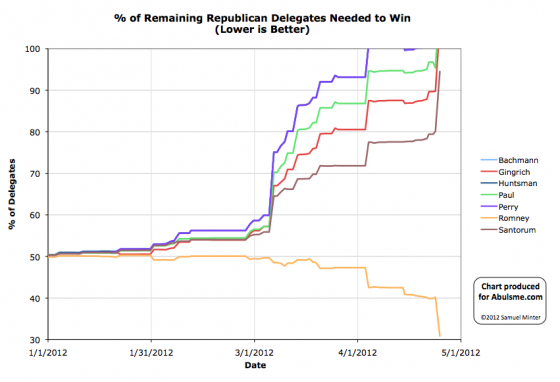
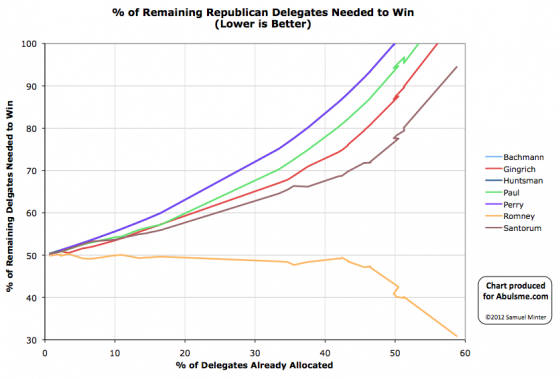
Charts from the Abulsme.com 2012 Republican Delegate Count Graphs page. When a candidate gets down to 0%, they have clinched the nomination. If they get above 100%, they have been mathematically eliminated. The first chart is by date, the second is by “% of Delegates Already Allocated”. These numbers include estimates of the eventual results of multi-stage caucus processes which will be refined as the later stages occur.
First big primary day in awhile, and of course Romney dominates.
- New York: Romney gets all 92 delegates from today. Total in NY now Romney 94, Gingrich 1
- Pennsylvania: This is the only tricky one of the day. Delegates were elected by name, not by presidential preference. So they are all officially uncommitted, but in general these delegates do support someone, it just takes more work to figure out who. Green Papers’ initial estimate from the primary is Romney +11, Paul +5, Gingrich +4, Santorum +3, and 39 uncommitted or unknown. That is obviously a lot of uncommitted/unknown, so there will probably be future updates as the preferences of those delegates become known. Also 10 at-large delegates won’t be chosen until June and two superdelegates have yet to publicly express a preference. The total in PA is now Romney 12, Paul 5, Gingrich 4, Santorum 3, TBD 48. (GP has Romney 11, TBD 49, but I think they forgot the one Romney superdelegate.)
- Connecticut: Romney wins all 25 delegates from the primary. New CT total: Romney 26, TBD 2
- Rhode Island: Romney gets 12 delegates from the primary, Paul gets 4. New RI Total: Romney 15, Paul 4
- Delaware: Romney gets all 17 delegates from the primary. No delegates had been allocated previously and none are left, so total is just Romney 17
So, for the day… Romney +157, Paul +9, Gingrich +4, Santorum +3. Romney gets 90.8% of the delegates today. Way more than the 40.2% he needed to stay on track to get to 1144.
And with this, Ron Paul and Newt Gingrich are both mathematically eliminated. More specifically, if they were now to get 100% of the remaining delegates they would still not get to 1144. In order to get to 1144, they would actually need to take delegates away from the other candidates, either through final results in caucus states being better for them than earlier estimates, or through actual defections. Both are possible. However, neither will happen in large enough numbers to change anything, absent something catastrophic that causes Romney to actually drop out. Uh, which is highly unlikely.
For the remaining two candidates, in terms of “% of remaining delegates needed to win”:
- Romney: 40.2% -> 30.9%
- Santorum: 80.1% -> 94.5%
So, theoretically Santorum could still catch up and win by getting 95% of the remaining delegates. Needless to say that won’t happen. His already long odds were made worse by suspending his campaign.
Meanwhile, neither Gingrich or Paul have suspended their campaigns. There are indications Gingrich might do so soon despite previous vows to stay in until Tampa. Paul has shown no signs of stopping.
The 31% of the remaining delegates Romney needs to wrap this up should be very easy for him to get. But we still have to wait for the calendar. So the march goes on…
Update 2012 Apr 27 12:34 UTC:
I was incorrect about the Pennsylvania count above and had misread Green Paper’s statement. In fact the new total in Pennsylvania was indeed Romney 11, not Romney 12. There were 10 new Romey delegates added to the count, not 11. They did not forget the one superdelegate. I just got twisted around thinking the 11 was a delta from the election instead of a new total, which would have left one delegate out. But it was indeed the new new total.
This makes the total for this day Romney +156, Paul +9, Gingrich +4, Santorum +3.
That gives Romney 90.7% of the delegates for the day instead of 90.8%.
This also changes Romney’s “% needed to win” to 31.0% instead of 30.9%. Santorum’s becomes 94.4% instead of 94.5%.
These changes are too small to be visible on the graph above, but will be reflected on future updates.
|
|












